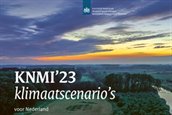Climate scenarios
Knowledge of our future climate is vitally important to keep the Netherlands accessible, liveable, and safe. What type of changes may occur in the future? What are the most likely developments? The climate scenarios compiled by the Royal Netherlands Meteorological Institute KNMI provide insight into such matters. This insight can help us to adapt optimally to the consequences of climate change.
The KNMI’23 climate scenarios
The most recent climate scenarios were published in 2023: the KNMI'23 climate scenarios, replacing the KNMI'14 climate scenarios. Together, the four KNMI'23 scenarios describe the corner points within which climate change is likely to proceed in the Netherlands:
- Hd: high emission levels and a “dry” scenario, involving slightly wetter winters and substantially drier summers;
- Hn: high emission levels and a “wet” scenario, involving substantially wetter winters and slightly drier summers;
- Ld: low emission levels and a “dry” scenario, involving slightly wetter winters and substantially drier summers;
- Ln: low emission levels and a “wet” scenario, involving substantially wetter winters and slightly drier summers.
What is the basis for the climate scenarios?
The KNMI climate scenarios are based on the latest scientific insights of the IPCC, the United Nations Intergovernmental Panel on Climate Change. With the KNMI scenarios, the KNMI is translating the global IPCC climate projections into a visualisation of the potential changes in the Dutch climate. The KNMI’23 climate scenarios are based on the insights contained in the 2021 IPCC report.
How can the scenarios be used?
How the climate scenarios are used, depends on various factors, such as the purpose, the time horizon, and the research field of a study. For example, KNMI has used the climate scenarios to indicate the expected annual average temperatures in its Climate dashboard.
What do the latest scenarios show?
The KNMI’23 climate scenarios paint a picture of higher temperatures, a more rapidly rising sea level, wetter winters, more severe downpours, and drier summers.
